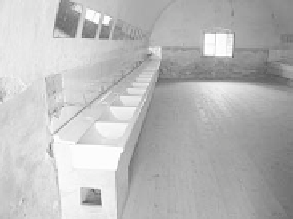Travel Reference
In-Depth Information
only moment of genuine emotion comes towards the end, when
a packed room of children applauds the final lines of the popular
anti-Nazi opera
Brundibár
, “We did not let ourselves down, we
chased the nasty Brundibár away. With a happy song, we won it
all.” Even the Nazis were not fooled: Gerron and his wife were
shipped to Auschwitz and the film was never shown in public.
To learn more about living conditions in the camp, walk over
to the
E
Magdeburg Barracks.
Peek inside the large courtyard
(you'll recognize it as the “soccer stadium” in Gerron's film), then
continue upstairs. On the right are rooms reproducing the camp
cabaret stage and exhibits documenting the prisoners' literary,
musical, and theatrical activities. On the left is a meticulously
restored camp dormitory, complete with three-tiered beds, eye-
glasses, dolls, chess boards, and sewing kits.
As you exit from the barracks (notice the high-water marks
from the 2002 flood on the house opposite), turn right around the
corner and walk 100 yards to a brick gate. As you cross a bridge
over a
R
dry moat,
imagine the moat filled with plots of vegetables
grown by starving Jews for well-fed SS officers.
Then turn left and walk along the moat. The top of the forti-
fication walls on the other side were once equipped with benches
and pathways. When you reach
the main road, turn right across
the New Ohře River (the original
course of the river was diverted
here when Terezín was bui lt)
and walk past the vast cemetery
to the
T
Small Fortress
—you'll
see its black-and-white-striped
gate. From 1940-1945 this fortress
functioned as a Gestapo prison,
through which 32,000 inmates passed (of whom nearly 10 percent
died here), chiefly members of the Czech resistance and commu-
nists. The 1,500 Jews interned here were treated with particular
severity.
Inside the gate, turn left towards the notorious
Arbeit Macht
Frei
sign (a postwar replica),
pa inted above an a rched
g a t e . I n t h e c o u r t y a r d
behind you will f irst f ind
Y
model prison cells.
The
washroom
in the left corner
was built solely for the pur-
pose of fooling Red Cross
inspectors. Turn the faucets:
No pipes were ever installed





















